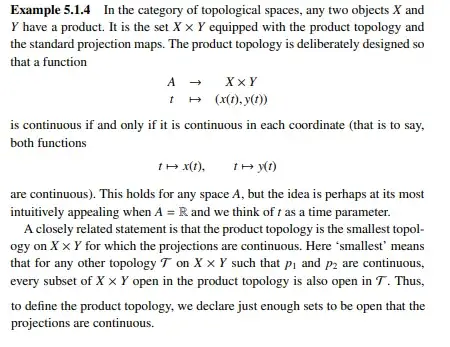A question about the example below quoted below (Example 5.1.4 from Leinster): Which definition of the product topology does he use? Wikipedia defines the product topology to be the coarsest topology for which the projections are continuous. But in the last paragraph of the example below, Leinster refers to this as a "statement", not as a definition. Then, does he use the definition that says that the product topology on $X\times Y$ is the topology whose basis consists of all sets of the form $U\times V$ where $U$ is open in $X$ and $V$ is open in $Y$? (That's how Munkres defines the product topology on $X\times Y$.)
If so, how does the statement that $t\mapsto (x(t),y(t))$ is continuous iff $t\mapsto x(t)$ and $t\mapsto y(t)$ is continuous follow?
One direction seems to be clear: if both one-variable functions are continuous, then the preimage of every open set under $x$ and $y$ is open. It suffices to show that the preimage of a basic open set under $\phi(t)=(x(t),y(t))$ is open. Let $U\times V$ be such a set, and consider $\phi^{-1}(U\times V)=\{t:x(t)\in U, y(t)\in V\}$. This is the intersection of the sets $\{t:x(t)\in U\}$ and $\{t:y(t)\in V\}$, which are open by assumption. So $\phi$ is continuous.
Coversely, if $\phi$ is continuous, we need to show that $\{t:x(t)\in U\}$ and $\{t:y(t)\in V\}$ are both open, where $U$ and $V$ are any open sets in $X$ and $Y$ respectively. We know that $\phi^{-1}(U\times V)=\{t:x(t)\in U, y(t)\in V\}$ is open, but I don't see how this implies that the two sets we're interested in are open.
